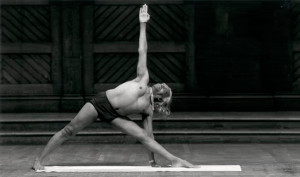 요가는 모두를 위한 것입니다. 아무리 나이가 들고 몸이 뻣뻣하고 살이 쪘고 말랐고 심신이 지쳐있어도 누구나 요가를 할 수 있습니다. 공식 아엥가 요가 강사는 학생의 나이와 신체적 조건에 맞게 누구나 요가를 안전하고 쉽고 충만감 있게 경험할 수 있도록 이끌어 줍니다.
요가는 모두를 위한 것입니다. 아무리 나이가 들고 몸이 뻣뻣하고 살이 쪘고 말랐고 심신이 지쳐있어도 누구나 요가를 할 수 있습니다. 공식 아엥가 요가 강사는 학생의 나이와 신체적 조건에 맞게 누구나 요가를 안전하고 쉽고 충만감 있게 경험할 수 있도록 이끌어 줍니다.
아엥가 요가 강사는 상당히 엄격한 기준과 책임을 필요로합니다. 공식 아엥가 요가강사의 자격은 오랜 기간의 연습과 교육 과정을 수료한 이후에만 주어집니다. 아엥가 요가 강사는 필요시에 학생 개개인의 조건에 맞게 블록, 담요, 벨트와 같은 도구를 사용하여 정통 자세를 변형하여 가르칠 수 있는 지식과 경험을 갖추고 있습니다. 요가 도구는 자세를 더 깊이 경험하기 위해서 혹은 자세에서 좀 더 오랜 머무름이 필요할 때 사용됩니다.
아엥가 요가 강사는 아사나(요가자세)에 대한 깊은 이해를 바탕으로 학생 개개인에게 적합한 방식으로 수업을 진행합니다. 수업에서 강사는 학생을 늘 관찰하고, 필요에 따라 학생의 신체를 직접 교정하기도 합니다. 아엥가 요가 강사의 특징은 아사나를 정확하게 구현할 수 있고, 관찰력이 높고, 몸에 대한 이해에 도움이 되는 핵심적인 지식을 전달한다는 점에 있습니다.
처음 아엥가 요가를 배우는 학생은 서서하는 아사나를 중점으로 기초 자세부터 익히게 됩니다. 이후 시간이 지나면 전굴, 후굴, 비틀기, 역자세, 이완의 자세들이 서서히 추가되어 배우게 됩니다. 단, 살람바 사르방가사나 (어깨 서기; Salamba Sarvangasana)는 치유의 효과가 있는 자세로 학생이 준비되면 첫 역자세의 하나로서 바로 익힙니다. 수업의 마지막은 깊은 이완으로 이어지는 샤바사나( Savasana)로 끝납니다. 이 자세로 학생은 완전히 몸을 이완 함으로써 마음이 내면의 평화에 다다르게 되고 동시에 아주 깊게 쉴 방법을 익히게 됩니다. 학생의 배움이 깊어지면 프라나야마 (숨의 조절; Pranayama) 를 배우게 됩니다.
강사들은 매 수업시간마다, 수업의 목적을 선택하고 이에 적합한 아사나들의 순서(시퀀스; Sequence)를 계획하여 수업을 구성합니다. 이 과정을 통해 강사는 아사나 간의 연결에 대한 이해를 깊게 하고 수업과 수업을 연결하는 노하우를 쌓아 나갑니다. 학생들은 수업 외 집에서도 연습하도록 격려를 받습니다. 스스로 하는 개인 연습 없이 요가는 완성되지 않습니다.
출처 – [http://iynaus.org/iyengar-yoga]
Yoga is for everyone. No one is too old or too stiff, too fat or thin or tired. A Certified Iyengar Yoga teacher can guide students of all ages and physical conditions to an experience of yoga, which is safe, accessible and rewarding.
Certified Iyengar Yoga instructors are held to an unusually rigorous standard. Only after years of training and evaluation do they become certified. Iyengar Yoga teachers modify the classic asanas (yoga postures) for individual students with the use of props such as blocks, blankets and belts. Props allow for a deeper penetration into the posture, as well as a longer stay.
Iyengar Yoga teachers use their deep-seated knowledge of the asanas to individualize corrections for each student. Students know they are observed and, if necessary, adjusted. Clear demonstrations of the posture, a well-developed eye, specific teaching points which awaken the body’s intelligence — these are the marks of an Iyengar Yoga teacher.
Students of Iyengar Yoga begin with elementary postures, with an emphasis on the standing asanas (postures). In time, other postures are added, including forward bends and back bends, twists, inversions and restorative poses. Salamba Sarvangasana (Shoulder Stand) is introduced as soon as students are ready because of its many therapeutic benefits. Each class ends with Savasana, corpse pose or deep relaxation. Students learn to rest in a profound way, completely releasing the body while drawing the mind towards the peace within.
As the student progresses, Pranayama (the control of the breath) is introduced.
Teachers devise sequences of poses, which build skill and understanding, from posture to posture, and from class to class. Students are encouraged to develop their own home practice; without one, the study of yoga is incomplete.
Retrieved from [http://iynaus.org/iyengar-yoga]